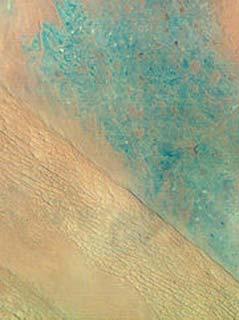Source:
04-23-2009 10:31
Sand covers only about 20 percent of Earth's deserts. Most of the sand is in sand sheets and sand seas—vast regions of undulating dunes resembling ocean waves "frozen" in an instant of time. In general, there are six forms of deserts:
◆Mountain and basin deserts
◆Hamada deserts, which consist of plateau landforms
◆Regs, which consist of rock pavements
◆Ergs, which are formed by sand seas
◆Intermontane Basins
◆Badlands, which are located at the margins of arid lands comprising clay-rich soil
 |
| Satellite view of Al-Dahna desert in Saudi Arabia showing different depositional features |
Nearly all desert surfaces are plains where eolian deflation—removal of fine-grained material by the wind—has exposed loose gravels consisting predominantly of pebbles but with occasional cobbles.
The remaining surfaces of arid lands are composed of exposed bedrock outcrops, desert soils, and fluvial deposits including alluvial fans, playas, desert lakes, and oases. Bedrock outcrops commonly occur as small mountains surrounded by extensive erosional plains.
Several different types of dunes exist. Barchan dunes are produced by strong winds blowing across a level surface and are crescent-shaped. Longitudinal or seif dunes are dunes that are parallel to a strong wind that blows in one general direction. Transverse dunes run at a right angle to the constant wind direction. Star dunes are star-shaped and have several ridges that spread out around a point.
Oases are vegetated areas moistened by springs, wells, or by irrigation. Many are artificial. Oases are often the only places in deserts that support crops and permanent habitation.
Editor:Yang Jie
